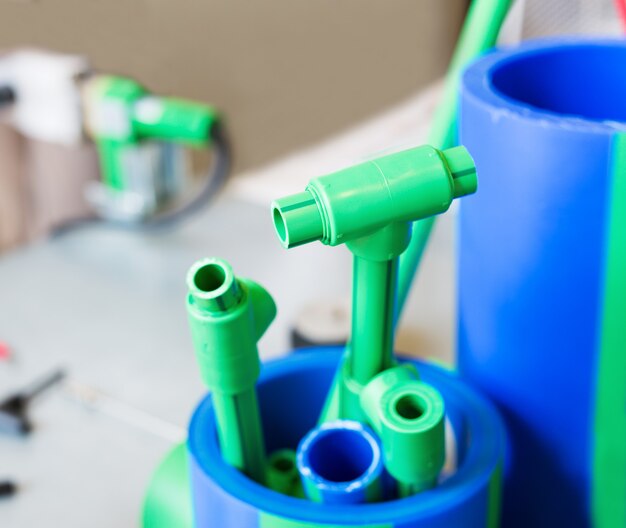Top Trends in Modern Pipes and Fittings

The world of pipes and fittings has undergone significant changes over the past few decades. As industries, homes, and infrastructures evolve, so do the materials, designs, and technologies behind piping systems. Here’s a look at some of the top trends that are shaping modern pipes and fittings, offering more efficiency, durability, and sustainability.
1. Sustainable and Eco-Friendly Materials
One of the most significant trends in the pipe and fitting industry is the shift toward eco-friendly materials. With growing concerns over environmental impact, manufacturers are focusing on materials that are sustainable, recyclable, and energy-efficient.
- Recycled PVC and HDPE (High-Density Polyethylene) are gaining popularity for their environmental benefits and long-lasting durability.
- Copper and PEX (Cross-linked Polyethylene) are also becoming more sustainable choices for plumbing, offering low maintenance and longer lifespan.
2. Smart Plumbing Solutions
With the rise of the Internet of Things (IoT) and smart home technologies, pipes and fittings are also becoming “smarter.” Smart plumbing systems are being integrated with sensors that help monitor water usage, detect leaks, and even automatically turn off the water in case of an emergency.
- Leak detection systems are now common in modern piping installations, helping prevent water damage and reduce wastage.
- Flow sensors help in maintaining optimal water pressure, preventing potential damage to pipes and fittings.
3. Cross-Linked Polyethylene (PEX) Pipes
PEX pipes have surged in popularity due to their flexibility, ease of installation, and durability. Unlike traditional metal pipes, PEX does not corrode, which extends its lifespan. Moreover, PEX pipes are resistant to scaling and chlorine, making them ideal for areas with hard water.
- Cold and hot water supply lines in both residential and commercial buildings are increasingly using PEX due to its cost-effectiveness and energy-efficient insulation properties.
- No soldering or welding is required, making installation faster and less expensive.
4. Corrosion-Resistant Materials
Corrosion is a constant issue in piping systems, especially in areas with hard water or extreme environmental conditions. As a result, the demand for corrosion-resistant materials is increasing.
- Stainless steel and composite materials are becoming more common in both residential and industrial settings.
- Copper alloys such as bronze and brass continue to be used because they are resistant to corrosion and provide long-term durability in a variety of applications.
5. Flexible and Modular Systems
Flexible and modular piping systems are trending in both commercial and residential construction. These systems allow for easy installation and modification, making them ideal for expanding or upgrading plumbing systems.
- Flexible couplings and modular pipe fittings offer a practical solution for installations in tight spaces or areas that require adaptability.
- Pre-insulated pipes are becoming more common to ensure better energy efficiency in heating and cooling systems.
6. Improved Jointing Techniques
Traditional soldering and welding methods for joining pipes are being replaced with more advanced jointing techniques. These modern methods ensure a quicker and more reliable connection.
- Push-fit fittings have become increasingly popular for their ease of installation. These fittings provide a watertight seal without the need for tools, adhesives, or soldering.
- Compression fittings are being adapted for higher pressure ratings and use in more demanding environments, ensuring robust connections and leak-free joints.
7. Pipe Insulation for Energy Efficiency
With rising energy costs, the demand for energy-efficient systems is growing. Insulating pipes helps minimize heat loss or gain, ensuring that heating and cooling systems work more efficiently.
- Foam-based insulation and thermal wraps are popular choices for maintaining the desired temperature of fluids within the pipes and reducing energy consumption.
- Insulated pipes are now available for both residential and commercial applications, allowing for energy savings in both heating and cooling systems.
8. Advancements in Pipe Coatings
Coatings and linings for pipes have evolved significantly, leading to enhanced durability and resistance to corrosion, chemical attacks, and wear and tear.
- Polyethylene and epoxy coatings are often applied to pipes to protect them from rust, abrasion, and other damages, especially in areas exposed to harsh environmental conditions.
- Non-toxic, eco-friendly coatings are now available, particularly for pipes used in drinking water systems, ensuring safety and maintaining water quality.
9. Robust Testing and Quality Control
With the increasing complexity of piping systems, advanced testing methods have become crucial in ensuring that pipes and fittings are durable and reliable.
- Modern testing methods such as pressure testing, leak detection systems, and ultrasonic inspection are being used more frequently to verify the quality of pipes and their fittings before installation.
- These innovations reduce the risk of future failures and leaks, ensuring a more reliable and cost-effective piping system.
